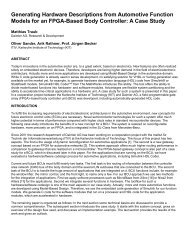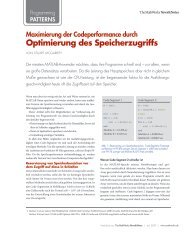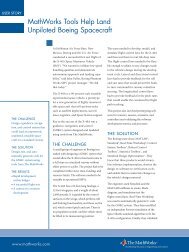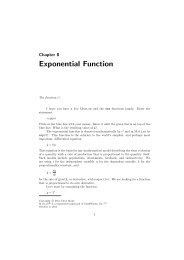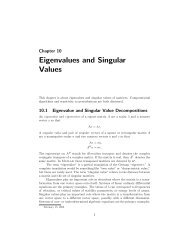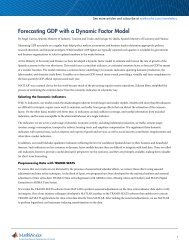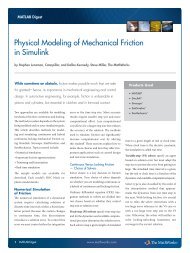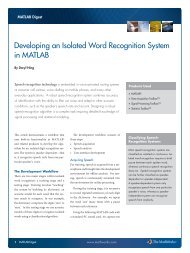Chapter 6. Quadrature - MathWorks
Chapter 6. Quadrature - MathWorks
Chapter 6. Quadrature - MathWorks
You also want an ePaper? Increase the reach of your titles
YUMPU automatically turns print PDFs into web optimized ePapers that Google loves.
<strong>6.</strong><strong>6.</strong> Integrating Discrete Data 11<br />
1.e-03 29.85834299237636 69 1.760e-05 0.018<br />
1.e-04 29.85832444437543 93 -9.511e-07 -0.010<br />
1.e-05 29.85832551548643 149 1.200e-07 0.012<br />
1.e-06 29.85832540194041 265 <strong>6.</strong>442e-09 0.006<br />
1.e-07 29.85832539499819 369 -5.005e-10 -0.005<br />
1.e-08 29.85832539552631 605 2.763e-11 0.003<br />
1.e-09 29.85832539549603 1061 -2.640e-12 -0.003<br />
1.e-10 29.85832539549890 1469 2.274e-13 0.002<br />
1.e-11 29.85832539549866 2429 -7.105e-15 -0.001<br />
1.e-12 29.85832539549867 4245 0.000e+00 0.000<br />
We see that as the tolerance is decreased, the number of function evaluations increases<br />
and the error decreases. The error is always less than the tolerance, usually<br />
by a considerable factor.<br />
<strong>6.</strong>6 Integrating Discrete Data<br />
So far, this chapter has been concerned with computing an approximation to the<br />
definite integral of a specified function. We have assumed the existence of a Matlab<br />
program that can evaluate the integrand at any point in a given interval.<br />
However, in many situations, the function is only known at a finite set of points,<br />
say (xk, yk), k = 1, . . . , n. Assume the x’s are sorted in increasing order, with<br />
a = x1 < x2 < · · · < xn = b.<br />
How can we approximate the integral<br />
b<br />
f(x)dx?<br />
a<br />
Since it is not possible to evaluate y = f(x) at any other points, the adaptive<br />
methods we have described are not applicable.<br />
The most obvious approach is to integrate the piecewise linear function that<br />
interpolates the data. This leads to the composite trapezoid rule<br />
n−1 <br />
T =<br />
k=1<br />
hk<br />
yk+1 + yk<br />
,<br />
2<br />
where hk = xk+1 − xk. The trapezoid rule can be implemented by a one-liner.<br />
T = sum(diff(x).*(y(1:end-1)+y(2:end))/2)<br />
The Matlab function trapz also provides an implementation.<br />
An example with equally spaced x’s is shown in Figure <strong>6.</strong>4.<br />
x = 1:6<br />
y = [6 8 11 7 5 2]<br />
For these data, the trapezoid rule gives







